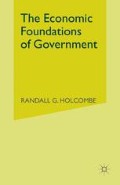Abstract
Government, by nature, is coercive. The fundamental transaction of government — the exchange of protection for tribute — makes government coercive because it must be in a position to forcibly deter aggressors in order to protect its citizens. Citizens want their governments to have the power to protect them, but this same power can be used against them too. Much of the analysis in previous chapters has been devoted to seeing how the government can obtain and use coercive power. The government profits from coercion by selling its output at monopoly prices. The government sells protective services, but also can produce and sell other goods and services. Some services have possible market alternatives; for example, governments produce mail services, television and radio broadcasts, health care, education, and more. When producing goods with private sector alternatives, the government typically has a competitive advantage. In some cases, it outlaws private sector competition, but another alternative is to subsidize or even give away its output, making it hard for private sector competitors to compete on the basis of price. Other services are not typically offered in private markets. For example, the government produces and sells barriers to entry into private markets in the form of tariffs and import quotas, regulation, licensing, and the granting of natural monopolies.
Access this chapter
Tax calculation will be finalised at checkout
Purchases are for personal use only
Preview
Unable to display preview. Download preview PDF.
Notes
See, for example, William J. Baumol, “Applied Fairness Theory and Rationing Policy,” American Economic Review 72 (September 1982), pp. 639–651,
and Randall G. Holcombe, “Applied Fairness Theory: Comment,” American Economic Review 73 ( December 1983), pp. 1153–1156, for differing views on fair pricing.
William A. Niskanen, “The Peculiar Economics of Bureaucracy,” American Economic Review 58 (May 1968), pp. 293–305, introduces his theory, which was elaborated in Bureaucracy and Representative Government (Chicago and New York: Aldine-Atherton, 1971), and extended in “Bureaucrats and Politicians,” Journal of Law & Econom-ics 18 ( December 1975), pp. 617–643.
This criticism of Niskanen’s suggestions appears in Earl A. Thompson, “Review of Niskanen’s Bureaucracy and Representative Government,” Journal of Economic Literature 11 (September 1973), pp. 950–953.
Harold M. Hochman and James D. Rodgers, “Pareto Optimal Redistribution,” American Economic Review 59 (September 1969), pp. 542–557, suggest that people can be better off if the government forces them to contribute to redistributive programs, for example.
Charles M. Tiebout, “A Pure Theory of Local Expenditures,” Journal of Political Economy 64 (October 1956), pp. 416–424.
Some of the limits of the Tiebout model are discussed by James M. Buchanan and Charles J. Goetz, “Efficiency Limits of Fiscal Mobility: An Assessment of the Tiebout Model,” Journal of Public Economics 1 (1972), pp. 25–43.
This is discussed in Richard B. McKenzie and Robert J. Staaf, “Revenue Sharing and Monopoly Government,” Public Choice 33, No. 3 (1978), pp. 93–97.
Harold Hotelling, “Stability in Competition,” Economic Journal 39 (March 1929), pp. 41–57 was the springboard for Anthony Downs, An Economic Theory of Democracy (New York: Harper & Row, 1957).
This aspect of political competition is discussed by Gordon Tullock, “Entry Barriers in Politics,” American Economic Review 55, No. 2 (March 1965), pp. 458–466.
Tullock’s model is similar to that of Harold Demsetz, “Why Regulate Utilities?” Journal of Law & Economics 11 (1968), pp. 55–65, who applies the argument to competition for a natural monopoly.
W. Mark Crain, Randall Holcombe, and Robert Tollison, “Monopoly Aspects of Political Parties,” Atlantic Economic Journal 7, No. 2 (July 1979), pp. 54–58, discuss competition for the right to be a political monopolist further.
This phenomenon is carefully documented by Alan T. Peacock and Jack Wiseman, The Growth of Public Expenditure in the United Kingdom (Princeton: Princeton University Press, 1961).
See also Robert Higgs, Crisis and Leviathan: Critical Episodes in the Growth of American Government (New York: Oxford University Press, 1987) for a slightly different interpretation.
Mancur Olson, Jr., The Rise and Decline of Nations (New Haven: Yale University Press, 1982).
See Harold J. Berman, Law and Revolution: The Formation of the Western Legal Tradition (Cambridge: Harvard University Press, 1983) for a discussion.
Armen Alchian and William R. Allen, University Economics, 3rd ed. (Belmont, California: Wadsworth, 1972), p. 7. In a latter work, they tone down their statement, arguing, “Although many social scientists (including economists) will offer all sorts of ethical assessments, what economic theory says must be distinguished from what an individual economist may prefer. The former is what counts, not the latter.” (original emphasis)
Armen Alchian and William R. Allen, Exchange and Production: Competition, Coordination, and Control, 2nd ed. (Belmont, California: Wadsworth, 1977), p. 19.
A discussion of choice subject to constraints and choice of constraints is given by James M. Buchanan, “Rational Choice Models,” Chapter 3, and Chapter 5, “Constitutional Economics,” in Explorations into Constitutional Economics (College Station: Texas A&M University Press, 1989).
John Maynard Keynes ended his book, The General Theory of Employment, Interest, and Money (New York: Harcourt Brace, 1936) by arguing, “the ideas of economists and political philosophers, both when they are right and when they are wrong, are more powerful than is commonly understood. Indeed the world is ruled by little else (p. 383).
Work such as Friedrich Hayek’s The Road to Serfdom (London: George Routledge & Sons, 1944)
and Milton Friedman’s Capitalism and Freedom (Chicago: University of Chicago Press, 1962) argue for social engineering in this sense, but argue that societies should be designed with less government. Neither Friedman nor Hayek fall in the group of individuals normally considered social engineers, yet they do promote ideas for redesigning government.
Author information
Authors and Affiliations
Copyright information
© 1994 Randall G. Holcombe
About this chapter
Cite this chapter
Holcombe, R.G. (1994). Competition in Politics. In: The Economic Foundations of Government. Palgrave Macmillan, London. https://doi.org/10.1007/978-1-349-13230-0_9
Download citation
DOI: https://doi.org/10.1007/978-1-349-13230-0_9
Publisher Name: Palgrave Macmillan, London
Print ISBN: 978-1-349-13232-4
Online ISBN: 978-1-349-13230-0
eBook Packages: Palgrave Economics & Finance CollectionEconomics and Finance (R0)

